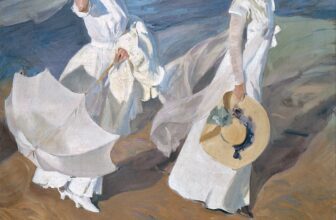
Meaning of A Boat in the Waters off Capri Painting
When we gaze upon A Boat in the Waters off Capri, the oil shimmers like a memory half-remembered, a whisper of salt and sun-drenched sea lingering just beyond the edge of touch. The painting, created by John Singer Sargent in 1878, is far more than a simple seascape. It is an intimate meditation on light, a fusion of travel, impression, and the interplay between nature and human presence. To understand this seemingly modest work is to enter the world of a young but already extraordinary artist, standing at the crossroads of 19th-century art, travel, and personal discovery.
The Life of Sargent in 1878
John Singer Sargent, born in 1856 in Florence to American expatriate parents, was already an artistic prodigy by the late 1870s. Having studied under the revered Carolus-Duran in Paris, Sargent was deeply influenced by the techniques of the Old Masters as well as the emerging innovations of Impressionism. By the age of 22, he had not only mastered the academic tradition but also begun to evolve a distinctive voice of his own, an artistic blend of realism, spontaneity, and lyrical romanticism.
1878 marked a transformative period in his life. Traveling through southern Europe, particularly Italy, Sargent was fascinated by light, color, and the rhythms of Mediterranean life. One such journey led him to Capri, the idyllic island off the Amalfi Coast, famed for its crystalline waters, mythic associations, and deep ties to classical art.
Here, with the Mediterranean sun drenching sea and rock in radiant hues, Sargent painted A Boat in the Waters off Capri, a small yet powerful composition that would become a hallmark of his exploration of light and reflection.
How A Boat in the Waters off Capri Was Painted
Sargent painted this piece en plein air, a method championed by Impressionists, involving the direct observation of a subject in the open air. But Sargent was not purely Impressionist. While Monet and Renoir were more inclined to abstraction and broken brushstrokes, Sargent married this observational immediacy with technical control and deliberate composition. His brush danced between fluid spontaneity and rigorous discipline.
The painting captures a single boat on the cerulean waters off the island of Capri, anchored or adrift in the sunlight. With loose, luminous brushwork, Sargent recorded the interplay of light and shadow on both the boat and the sea, portraying the water not as a mere background but as a dynamic, living entity. The painting likely involved rapid application of paint, using long, sweeping strokes and small, dappled gestures to catch the glimmers and shifts in light.
The perspective is elevated, almost as though we, the viewers, are hovering just above the waterline, watching the scene unfold from a slightly godlike view. This view grants a detached serenity, as if inviting us into a meditative state.
What the Painting Is About: Layers of Representation
At first glance, A Boat in the Waters off Capri appears deceptively simple. But beneath its placid surface lies a complex interplay of themes: solitude, observation, transience, and harmony between humanity and nature.
The lone boat in the expanse of water suggests a pause, a moment suspended in time. Is it waiting? Resting? Has its occupant left to explore the cliffs, or are they simply basking in the Mediterranean quietude?
The absence of a human figure might suggest that the boat has become a symbol, a vessel not just of wood and sail, but of journey, potential, and solitude. In many cultures, boats are symbols of transition, passage, or even the soul’s voyage. In this sense, Sargent’s painting becomes not just a record of Capri’s waters but a poetic meditation on human presence and impermanence.
Symbolism and Deeper Meaning
Though Sargent was not explicitly a Symbolist, many of his paintings, including A Boat in the Waters off Capri, can be read as rich in symbolic content.
1. The Boat as a Metaphor for Self
The solitary boat is often interpreted as a metaphor for the self, a human consciousness floating in the vast sea of existence. With no captain or passenger visible, it becomes a kind of existential object, navigating the unknowable, floating between the firm reality of shore and the fluid uncertainty of the open sea.
2. Water as Emotion and Subconscious
Water, particularly in the Western artistic tradition, often represents the emotions, the subconscious, or the divine feminine. The Mediterranean sea, with its layers of blues and shifting reflections, can be seen as a mirror of the artist’s interiority. The reflections in the water suggest how unstable, how illusory, even the most solid things can be.
3. Light as Spirit and Time
Sargent’s obsession with light, its shimmer on surfaces, its ability to transform even the mundane, takes center stage here. The way the light caresses the sides of the boat, glints off the gentle waves, and dances in the wake suggests a spiritual dimension. Light here is not just physical, but metaphysical, a symbol of time, beauty, and ephemerality.
What Is Happening in the Painting?
The narrative, if any, is intentionally subtle. A boat is either docked or drifting. The day is still. The waters are calm. It is a moment without urgency, devoid of drama. There is peace in the composition, but also mystery.
Who owns the boat? What lies just beyond the frame? Why was this moment chosen to be immortalized?
The lack of human figures intensifies the feeling that this is a moment for reflection, not action. The boat may be waiting to begin its journey, or it may be ending one. Either way, it is at rest, and that restfulness is contagious.
Type and Style of Art
A Boat in the Waters off Capri belongs to the broader category of Impressionist realism, a genre that blends the directness and spontaneity of Impressionism with the structural clarity of realist painting.
It is:
Plein air painting – painted outdoors, directly from life.
Impressionist-influenced – though Sargent did not consider himself strictly an Impressionist, he borrowed their color palette and attention to light.
Tonal – the limited, harmonious palette suggests tonalism, where mood takes precedence over detailed realism.
Atmospheric – the atmosphere is rendered more powerfully than narrative or subject.
In many ways, it also echoes the luminism of American art, where the effects of light and tranquility of scene override dramatic subject matter.
Where Is the Painting Now?
A Boat in the Waters off Capri is currently housed at The Metropolitan Museum of Art in New York City. It is part of their vast American art collection, a testament to Sargent’s status not only as a global artist but as one of the preeminent American painters of his generation.
The painting’s relatively small size and quiet subject matter make it easy to overlook among Sargent’s more dramatic portraits and genre scenes. Yet for those who stop and truly look, it offers a kind of meditative grace, an oasis of calm in the visual cacophony of modern life.
Cultural Significance
While A Boat in the Waters off Capri may not be as widely known as Sargent’s portraits of society women or grand murals, it is one of the most lyrical, contemplative, and emotionally resonant works in his oeuvre.
It foreshadows the kind of mature landscape work that Sargent would pursue more heavily later in life, when he tired of portrait commissions and retreated to more private expressions of creativity.
This painting also anticipates later movements in art:
The Symbolist movement’s interest in internal states and dreamlike imagery.
The Modernist shift away from narrative and toward pure feeling and formal harmony.
Even Abstract Expressionism owes something to the brushy, loose surface textures that artists like Sargent were already exploring.
A Quiet Revolution in Paint
A Boat in the Waters off Capri may seem quiet, even unassuming, but it represents a turning point, not just in Sargent’s career, but in the history of modern art.
It shows that a painting doesn’t need grand subjects or complex narratives to be profound. Sometimes, a single boat, a patch of sea, and the whisper of Mediterranean light are enough to evoke the soul’s journey, the beauty of stillness, and the eternal dance between light and form.
In this way, Sargent offers not just an image, but an invitation: to see more, to feel more, to drift, if only for a moment, into a world where the ordinary becomes extraordinary under the artist’s gaze. image/wikiart




